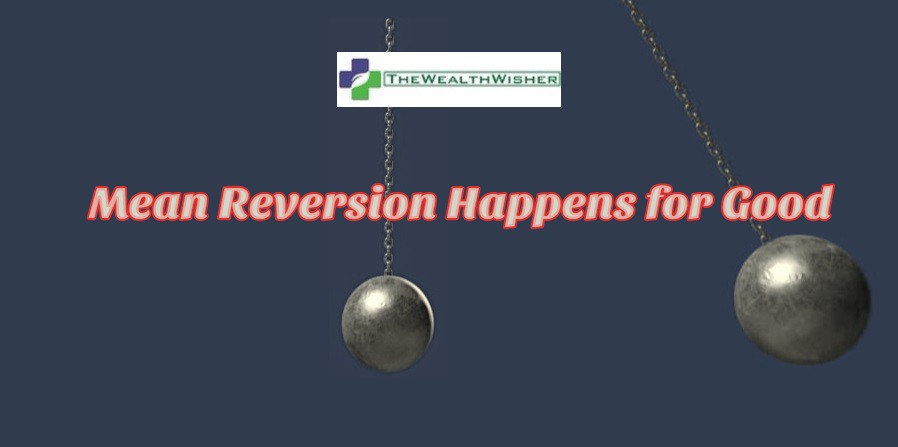Mean reversion is a powerful way to understand equity investing. When you see markets you are seeing a pendulum in working. Some good happens markets go up 600 points, something bad happens it sheds 500 points. You cannot control that, but surely you can rely on mean reversion to not feel the panic. Let’s see details of Mean Reversion in equity markets and few examples.
It is said that the main drivers of markets are – emotions, changing expectations, liquidity and mean reversion.
“Mean” is a statistical word. Don’t worry nothing technical here. Mean simply means average. When someone asks you what is gold nowadays?
Rs 30000 per 10 gms- You reply.
You don’t say it was Rs 29900 on Monday, then Rs 31600 on Tuesday & Rs 30678 on Wednesday. You just calculate an average price that justifies the prevailing price trends. This is averaging.
Reversion means “to revert or go back”.
Meaning of Mean Reversion
 Mean reversion says that what goes up should come down, and vice versa. The level to which it comes back is the average price.
Mean reversion says that what goes up should come down, and vice versa. The level to which it comes back is the average price.
Mean reversion is the theory that can be applied to interest rates, security prices (Equity Share prices and mutual fund NAVs), or various economic indicators will, over time, return to their long-term averages after a significant short-term move.
This short-term move is called volatility. The upward or downward movement of price.
Why Mean Reversion happens?
The answer to the reason why mean reversion happens is Abnormality is short term, Rationality prevails in long run”.
To simplify my above statement, let me put some more statements:
- The year 2017 was abnormal for equity returns. (Sorry, you are happy to get 25 or 35% returns, but I know long term you will get only 12% to 15%)
- The developed markets have given average 8.4% returns from 1900 to 2017.

- The property has only given 2% or fewer returns in developed markets from 1900 to 2017. (After RERA we can also assume that our real estate industry will move towards developed economic indicator.

Mean reversion is called “rule of physics” in investing.
It ensures that prices will go down what is justified. In shares or equity, the justified price is directly correlated to the earnings.
So, profits decide the price of an equity share.
So if Reliance Industries is trading at a long-term average of Rs 1000 with each year profit is 20%, so in a theoretical environment, the price of this security will be 1200 max.
Suppose sentiments get spoiled due to government instability and price fall to 880. You can assume that whenever normalcy will resume the price will rise to Rs 1200.
This works in reverse manner reverse too.
Are the markets in Mean Reversion Phase?
This is how mean reversion is happening now. In October 2017 itself, all market indicators suggested that markets have peaked and either earnings (profit generated by corporates) should increase or fair valuation has been achieved.
But market went up ahead on the back of huge outflow from domestic mutual fund investors. Also, markets did not budge during Gujrat Election incident also. Clearly, it was a sign that it moved above MEAN.
Now, what do we see? A reversal to mean.

This is the reason Mean Reversion is considered as one of the most powerful and reliable drivers of long-term capital markets returns.
To be sure, mean reversion works its magic slowly, so has to wait a long time for values to revert. That is why all equity pundits say “patience is the key in equity markets”.
A huge part of this current market crash is mean reversion towards more sensible risk premiums.
Other Uses of Mean Reversion
Means reversion applies to all concepts which undergo price changes due to changes in external factors.
For Eg:
- Do you think FDs at a rate of 6.5% is normal? No, It has a fair chance to revert to 7-8%.
- Will housing loans be available at 8.3% for long? No, they will cross 9.5% when the rate reverse.
- You remember when present government came the price of crude oil was around 35$/barrel. Now it has stabilized at 60-65$/barrel.
So mean reversion is happening to most of the economic commodities around us.
Mean reversion is widely used by traders, but as investors, we have a lesson:
Never be happy or sad at abnormal times. Nature will take its course sooner or later.
Hope you learned an important lesson today. It will help you see things more clearly as an investor.
Share your views and do forward the article to let others know that you read good things.










